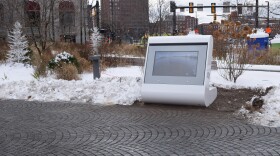At this time of year, we tend to turn away from the Great Lakes, counting down the days until we can swim, fish, or go boating. But a new show at a Cleveland art gallery looks at Lake Erie from a perspective we rarely see – the icy one.
During the summer, Lake Erie’s western basin is full of boaters and tourists, especially near the islands that lie west of Cleveland. But come winter, the lake is empty, still, and sometimes frozen.
This is the drive behind Julia Christensen’s newest art project, Waiting for a Break.
“I wanted to build a living project about the Great Lakes, where we could bring images from points not accessed by humans into the public sphere throughout the course of the winter,” she said.
Seven cameras along the lakeshore
The project consists of seven cameras located at the western end of Lake Erie. Directed at the water, they provide a 24-hour, real-time view of what’s happening on the lake. Cameras look out to South Bass Island marinas and a pier or two. Another camera points to a nearby power plant.
Christensen, an art professor at Oberlin College, has been tracking Lake Erie’s ice since December.
Nick Greenawalt, a National Weather Service Meteorologist, says this year’s been pretty unusual. "Our cold snap was actually pretty early. We saw well-below normal temperatures for the last half of December.”
Western Lake Erie is different from all of the Great Lakes – it’s the shallowest part of the region, and is most responsive to weather patterns.
“It’s kind of the most dynamic ice growth and decay that we see along many of the Great Lakes,” Greenawalt said.
A kiosk in Public Square with a view of the lake
I wanted to build a living project about the Great Lakes, where we could bring images from points not accessed by humans into the public sphere throughout the course of the winter
The first part of Waiting for a Break is a white kiosk set up at Public Square in the heart of downtown, commissioned by LAND Studio. It shows the live feeds to folks passing through. The project’s second component is now open at SPACES Gallery in a west side neighborhood less than a mile from the lake.
The exhibit is a mix of time-lapse videos, screenshots from the live feeds, and a “reading room” – books and maps Christensen used in her research.
One time-lapse video compresses three weeks of footage into three hours -- they play on screens side by side. Time moves quickly as ice forms and breaks into tiny pieces, floating in the lake. The series of pictures shows the lake at 5 p.m. over a couple of weeks.
And Cold Snap, another time-lapse video, chronicles the very cold week at the beginning of this year…when Lake Erie ice cover jumped from 30 percent to 70 percent.
It will all remain at SPACES until March 23.
Connecting with the gallery's mission
Christina Vassallo, the gallery’s executive director, says Waiting for a Break connects with the gallery’s message – it confronts an issue of local and international significance. But it also shows a side of the lake most of us never see.
“What Julia reveals to us through her footage are all of the nuances and this incredible, dramatic waterscape,” she said. “You can actually see the ice forming and shifting and moving.”
The project is educational, too -- a visual lesson on how Lake Erie changes over time.
A usefull tool for meteorologists
Even meteorologists like Greenawalt look to on-the-ground photos and videos to see the lake’s current conditions when satellite images don’t work.
“Satellite data becomes limited if you have clouds because we can’t actually see what’s happening on the lake’s surface,” Greenawalt said. “So having real-time observations is crucial for us to understand what’s truly happening on the lake.”
And Christensen wants Waiting for a Break to emphasize that what happens during the winter has year-round consequences.
“Ice coverage is related to water evaporation, and the harmful algae blooms we’ve been seeing, and any number of complex issues on the lake,” she said.
The good news is that the ice will melt, eventually. For Lake Erie, that usually happens at the end of March.
Great Lakes Today is a collaboration of WBFO Buffalo, ideastream Cleveland, and WXXI Rochester.



